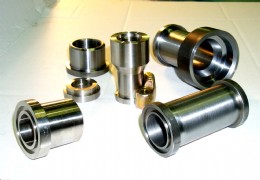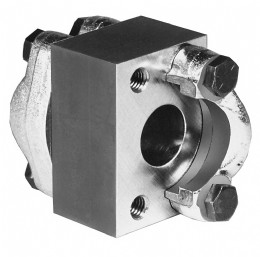View from the other side

ISO 6162-1 split flanges and ISO 6162-1 flange heads to a variety of other standards (photo: Main Manufacturing Products Inc.)

Connector block to the ISO 6162-1 standard for hydraulic flanges (photo: Main Manufacturing Products Inc.)
Automated valves and security - by Chris Warnett
In todays environment of security awareness there is a heightened concern over maintaining the integrity of plant operations.
The causes of undesired interference with plant and industrial installations ranges from plant operator ignorance or error to vandalism and then the ultimate concern, terrorism.
Equipment behind a plant’s security fence is less vulnerable than equipment on a remote installation, like an unmanned pump station for example. However, the desire to reduce interference from all causes, warrants consideration of all potentially vulnerable devices.
The valves used in a plant are particularly important devices. Opening or closing a valve at the wrong time could cause a catastrophic leak, contamination or hazardous situation that may put personnel and equipment at risk.
Valves fall into two broad categories, manually operated and automated. The manual valve, if critical, will usually have some mechanical key operated lock out system that prevents plant personnel from inadvertently moving the valve unless a security or safety process is adhered to.
Automated valves are a little more complicated. Certainly many automated valves have local manual controls and hand wheels that can be used to move the valve. These can be mechanically locked in a similar way to a manually operated valve. The complication comes with the remote controls of the valve that are located in a control room at some distance from the valve itself. Furthermore, many modern valve actuators have wireless or other non-intrusive set up communications methods that also need to be secure from unauthorized tampering.
A possible unintended or unauthorized movement of an automated valve could come from two main sources, regardless of whether the valve actuator type is electric, pneumatic, hydraulic or any other.
1) An equipment malfunction in the control system, field instrumentation or valve actuator itself.
2) An unauthorized movement deliberately caused by an external actor
With regard to equipment malfunctions, there are methods of mitigating the possibility of failure, this is quantified in a critical safety instrument system (SIS). The safety Integrity level (SIL) of an installation can be assessed using standards defined by the international Electro-technical Commission (IEC). Some valve actuators have been tested by third party testing establishments to operate at certain SIL levels. These actuators offer the ability to increase the integrity of the process by monitoring the actuator output as well as the control signal integrity.
For critical automated processes many systems use a triple redundant control system to ensure the integrity of signals sent process equipment including the automated valves.
A more recent area of concern in control systems is the guarding against cyber-attack. Major suppliers now incorporate substantial safeguards to counter this possibility. Most valve actuators have a selector to choose either “local” (at the valve) or “remote” (control room) operation. When the “local” position is selected the valve can be moved by pushbutton controls on the actuator or on a local control station, if present. However these local controls are disabled if “Remote” is selected.
The remote position places the control exclusively with the remote control system. To prevent tampering the selector can be padlocked in the “remote” mode. To further prevent tampering a “vandal proof” cover can be padlocked to cover the entire selector assembly. In some extreme circumstances the local selector and pushbuttons can be removed entirely, but alternative means of local control then need to be provided. This is possible with some non-intrusive set up devices.
Valve actuator hand wheels invariably have a provision for padlocking to prevent manual engagement.
The other mode of intervention could be through the non-intrusive set up arrangement. There are a variety of these set up methods. Some use the actuator pushbuttons, some use an infrared link (IrDA) but an increasing number use a standard Bluetooth connection.
There are some simple methods of preventing unauthorized tampering with these set up modes.
The pushbutton setup method can be padlocked to prevent interference.
The Infrared setup method is usually only active when the actuator is in the “local” mode. This means it can have the added protection of the padlocked selector. Further protection can be provided by the use of password protection. Some manufacturers also utilize a dedicated set up tool to ensure a further level of protection.
The Bluetooth method of communication typically uses a mobile Bluetooth device to communicate with the actuator. Proprietary communication software is usually freely available on most manufacturers’ websites. There are several layers of protection on most valve actuators to prevent unauthorized interference.
In order for the actuator to be visible to the Bluetooth device, the control selector would need to be in the “local” position, so direct access to the actuator is necessary. This selector may be padlocked to further prevent unauthorized movement. The Bluetooth device would then need to enter the correct password to communicate with the actuator. So three levels protection are available.
Despite these protective precautions, some sensitive end users have banned all wireless instrument communications. In these circumstances some manufacturers have the ability to deactivate their Bluetooth communications after actuator set up.
The tampering prevention on pneumatic actuators is similar to that of an electric actuator. A manual override is not always standard on a fluid powered actuator, but when supplied, it also can be padlocked to prevent tampering. The controls in some cases have similar “local / remote” selection and can be made tamperproof by the manufacturer, if requested by the user.
There is an important advantage of the automated valve when considering the problem of security and safety. That is, the monitoring capability that comes with the integral position sensors on the automated valve. Control systems have the ability to raise an alarm should there be any unauthorized movement of the valve or the local actuator controls. This monitoring is constant and continuous and would alert control room personnel to any problems in the field. In addition, a time stamped record of all events can be logged by the control system or actuator data loggers.
The value of standards - by Karen Mackey
From quality systems to freight containers to screw threads, standardization has made much of our modern economy and global markets possible. As valuable as many existing standards are, new and updated standards are always needed to keep business humming along. Having spent the last 28 years helping the hydraulics and pneumatics industry write International Standards, I have had a front-row seat to observe how the industry, the companies that produce and use these products, and the individuals who participate have benefitted from standards and standards development.
Industry
An industry that takes standardization seriously demonstrates its concern for the development and dissemination of the technology it sells. Well-conceived and well-drafted standards make it possible for customers to apply your technology – and by extension, your company’s products -- more easily, safely and effectively, and at a lower cost. In the European Union, standards are being used to implement laws like the Pressure Equipment Directive; in these cases, industry-organized standards work ensures that the expertise of those who make and use products covered by the directive is incorporated into the rules.
Producers
Standards can help reduce unnecessary variety, leading to lower design costs and greater economies of scale for those who manufacture. Standards can also provide a shorthand way of communicating product features to customers; by producing a valve that conforms to a standard, the manufacturer can take advantage of the information embedded in the standard to help his customer identify what he needs.
Users
Standards provide users with lower prices (due to those previously-mentioned economies of scale) and information about a product before going to the marketplace to find a supplier. Product testing standards allow users to compare various manufacturers’ products on a level playing field. The development of some of these testing standards is straightforward, but others involve significant testing programs to verify the procedure. For example, the pneumatics industry has developed standards for assessing the reliability of its components and, in response to market needs, continues to conduct testing to improve the standards, leading to more accurate reliability data for users of pneumatic components.
Large vs. small enterprises
Many people believe that standardization automatically benefits larger companies, but standardization is one area where a smaller company can “punch above its weight” in the marketplace. A company that develops an effective strategy and devotes the necessary time, expertise and attention can have a significant impact on even international standards. One smaller U.S. company I know makes it a priority to work on the standards that have the most impact on its business and leads by actually doing the technical research for and writing of these standards. As a result, this company can share additional insight with its customers and has advance notice of, and influence on, changes that affect its products.
Individuals
While the main benefits of standardization belong to industry and companies, the people who actually do the work of developing standards also benefit. Standards committees are places where you can interact with your peers in the industry and develop and put into practice teamwork and leadership skills that you can use back at your company. Your participation in standards work can provide you with product and market intelligence that is not available anywhere else, whether it be the history of a particular product, or application problems that others bring to the committee to solve via a standard.
The bottom line – If your company’s products are affected by standards, you need to be involved. It’s easy to do; your BVAA and the British Standards Institution (www.bsigroup.com) have information on which groups are working on standards for your company’s products and how you can join them. Before you get involved, be sure to consider what return you want from your investment of time and expertise so that, after you get involved, you can evaluate your experience. Remember that standards committees are most effective when participants and the industry and its customers find value in the standards produced.

| Telephone: | 01295 221270 |
| Email: | enquiry@bvaa.org.uk |
| Website: | www.bvaa.org.uk |
| More information on the British Valve and Actuator Association BVAA Member Directory Page |
Search related valve / actuator articles: British Valve and Actuator AssociationIssue 31BVAA NewsNews













